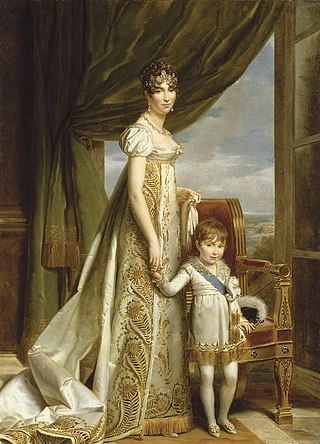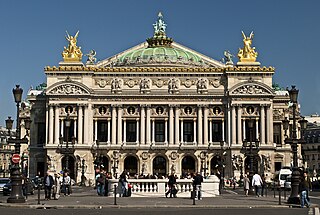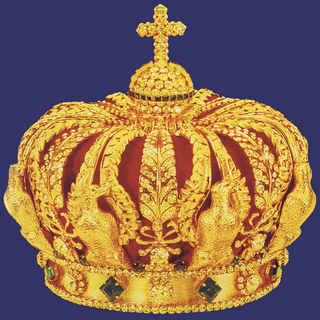Portrait of Napoleon III may refer to:
Portrait of Napoleon III may refer to:
Napoleon (1769–1821) was a French military leader and emperor.

Napoleon III was the first president of France from 1848 to 1852, and the last monarch of France as the second Emperor of the French from 1852 until he was deposed on 4 September 1870.

Hortense Eugénie Cécile Bonaparte was Queen of Holland as the wife of King Louis Bonaparte. She was the stepdaughter of Emperor Napoléon I as the daughter of his first wife, Joséphine de Beauharnais. Hortense later married Napoléon I's brother, Louis, making her Napoleon's sister-in-law. She became queen consort of Holland when Louis was made King of Holland in 1806. She and Louis had three sons: Napoléon-Charles Bonaparte; Napoleon III, Emperor of the French; and Louis II of Holland. She also had an illegitimate son, Charles, Duke of Morny, with her lover, the Comte de Flahaut.

Joséphine Bonaparte was the first wife of Emperor Napoleon I and as such Empress of the French from 18 May 1804 until their marriage was annulled on 10 January 1810. As Napoleon's consort, she was also Queen of Italy from 26 May 1805 until the 1810 annulment. She is widely known as Joséphine de Beauharnais.

Eugénie de Montijo was Empress of the French from her marriage to Napoleon III on 30 January 1853 until he was overthrown on 4 September 1870. From 28 July to 4 September 1870, she was the de facto head of state of France.
Louis Napoleon (1808–1873) was Emperor of France from 1852 to 1870.

The Élysée Palace is the official residence of the President of the French Republic in Paris. Completed in 1722, it was built for Louis Henri de La Tour d'Auvergne, a nobleman and army officer who had been appointed Governor of Île-de-France in 1719. It is located on the Rue du Faubourg Saint-Honoré in the 8th arrondissement of Paris, near the Champs-Élysées. The name Élysée derives from the Elysian Fields, the place of the blessed dead in Greek mythology.

Alexandre Cabanel was a French painter. He painted historical, classical and religious subjects in the academic style. He was also well known as a portrait painter. He was Napoleon III's preferred painter and, with Gérôme and Meissonier, was one of "the three most successful artists of the Second Empire."

Emperor of the French was the title of the monarch and supreme ruler of the First French Empire and the Second French Empire. The emperor of France was an absolute monarch.

Napoléon-Louis Bonaparte was King of Holland for less than two weeks in July 1810 as Louis II. He was a son of Louis Bonaparte and Queen Hortense. His father was the younger brother of Napoleon I of France who ruled the Napoleonic Kingdom of Holland from 1806 to 1810. His mother was the daughter of Josephine de Beauharnais, Napoleon's first wife. His younger brother, Louis-Napoléon, became Emperor of the French in 1852 as Napoleon III.

Napoleon Crossing the Alps is a series of five oil on canvas equestrian portraits of Napoleon Bonaparte painted by the French artist Jacques-Louis David between 1801 and 1805. Initially commissioned by the King of Spain, the composition shows a strongly idealized view of the real crossing that Napoleon and his army made along the Alps through the Great St Bernard Pass in May 1800.
Events from the year 1852 in France.

Second Empire style, also known as the Napoleon III style, is a highly eclectic style of architecture and decorative arts originating in the Second French Empire. It was characterized by elements of many different historical styles, and also made innovative use of modern materials, such as iron frameworks and glass skylights. It flourished during the reign of Emperor Napoleon III (1852–1870) and had an important influence on architecture and decoration in the rest of Europe and North America. Major examples of the style include the Opéra Garnier (1862–1871) in Paris by Charles Garnier, the Institut National d'Histoire de l'Art, the Church of Saint Augustine (1860–1871), and the Philadelphia City Hall (1871–1901). The architectural style was closely connected with Haussmann's renovation of Paris carried out during the Second Empire; the new buildings, such as the Opéra, were intended as the focal points of the new boulevards.

The hand-in-waistcoat is a gesture commonly found in portraiture during the 18th and 19th centuries. The pose appeared by the 1750s to indicate leadership in a calm and firm manner. The pose is most often associated with Napoleon Bonaparte due to its use in several portraits made by his artist, Jacques-Louis David, amongst them the 1812 painting Napoleon in His Study. The pose, thought of as being stately, was copied by other portrait painters across Europe and America. Most paintings and photographs show the right hand inserted into the waistcoat/jacket, but some sitters appear with the left hand inserted. The pose was also often seen in mid-nineteenth century photography.
French Empire may refer to:

Bonaparte at the Pont d’Arcole is an oil-on-canvas painting executed in 1796 by the French artist Antoine-Jean Gros. It depicts an episode during the Battle of Arcole in November 1796, with General Napoleon Bonaparte leading his troops to storm the bridge.

Virginia Oldoini Rapallini, Countess of Castiglione, better known as La Castiglione, was an Italian aristocrat who achieved notoriety as a mistress of Emperor Napoleon III of France. She was also a significant figure in the early history of photography.

Portrait of Napoleon III is an oil painting of 1861 by the French painter Hippolyte Flandrin, depicting France's Emperor Napoleon III standing in his Grand Cabinet. It is held at the Musée de l'Histoire de France, in Paris. At its first presentation in the Universal Exhibition in 1862, the painting attracted praise for its true-to-life representation of Napoleon III.

The Crown of Napoleon III was a crown that was made for Napoleon III, Emperor of the French. Although he did not have a coronation ceremony, a crown was made for him on the occasion of the 1855 Exposition Universelle in Paris. The gold crown had eagle-shaped arches and others in the form of palmettes, set with diamonds, and topped by a monde.

Portrait of Napoleon III was an oil on canvas painting by the German portrait painter Franz Xaver Winterhalter, created in 1853. It was an official portrait of the French Emperor Napoleon III, who reigned as Emperor of the Second French Empire from 1852 to 1870. The work had the dimensions of 240 cm high and 155 cm wide. The original portrait was lost in a fire in the Tuileries Palace, in Paris, in 1871, but its known by the large number of copies made by other painters during the emperor's reign.